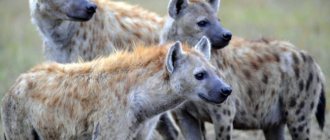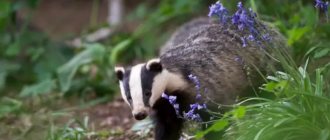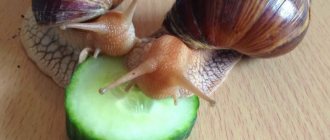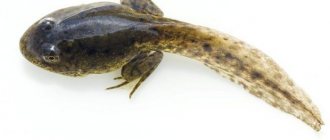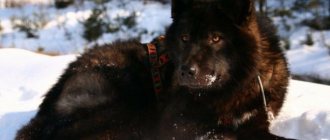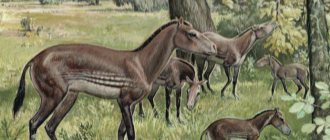Badger: description
Regardless of species, all badgers are considered the largest representatives of a fairly large family of mustelids. Despite their clumsiness, badgers have a well-built body, which widens towards the rear.
Appearance
Badgers have an elongated body, while the eyes are relatively small, as are the ears, which are round in shape. At the base of the tail there are special glands that secrete an odorous liquid, which is quite caustic. Due to this secret, animals recognize their relatives and also communicate with each other. This animal has short but strong limbs, armed with powerful but weakly curved claws that help the animal dig the ground. The soles of its paws are bare, not covered with bristles. Molars are flattened in shape and are intended for grinding food of plant origin.
The entire body and tail are covered with coarse, relatively long guard hair, while the presence of undercoat is noted, which is shorter and softer. The head and limbs are covered with shorter hairs. Badgers molt quite slowly, so this process extends throughout the entire summer period. First of all, the animal gets rid of the undercoat, and in the summer the guard hair is replaced. Closer to autumn, the old fur falls out more actively, and the new coat begins to form more actively.
Interesting to know! Males are noticeably larger than females, and their body length can reach 0.9 meters with a body weight of about 25 kilograms. The tail is about a quarter of a meter long. Before hibernation, badgers can weigh up to 10kg more than normal.
The nature of the color depends on the living conditions, although it is believed that the main color of badgers is associated with grayish-brown shades, while the top of the dorsal region has a darker shade, forming a dark longitudinal stripe. The lateral parts of the body have white inclusions, in the form of a kind of “ripple”. The head area also has a black stripe that runs across the badger's eyes and nose, while it may cover the ears or simply touch the top edges of them. The coat in summer is characterized by a darker color, with the presence of reddish tones. Juveniles do not have such contrasting coloring compared to adults.
Interesting facts about Badger
Behavior and lifestyle
As a rule, badgers try to lead a sedentary lifestyle, becoming attached to their territory. Individual plots can have an area of about half a thousand hectares, or even more. Individual individuals live in simple burrows, with an exit and an entrance, as well as a nesting chamber. Groups of badgers form so-called “fortifications”, which are distinguished by a rather complex, multi-tiered structure. This structure includes numerous entrances and exits, as well as ventilation ducts. In such “fortifications” there are also longer tunnels, which end in very voluminous nesting chambers.
As a rule, the nesting part is covered with dry components. Such chambers are located below the level of waterproof layers, which reliably protects the nesting chambers from groundwater or from precipitation.
Adults regularly renew the litter layer, removing almost all of the litter, which quickly becomes unusable.
Important to remember! Badgers, as a rule, do not show unmotivated aggression towards people or other animals. Despite this, badgers are able to actively defend themselves in case of danger. They bite painfully and also painfully hit uninvited guests with their noses.
Animals such as foxes and raccoon dogs often occupy badger holes. With the onset of winter cold, these animals hibernate, and their body temperature drops to 34 and a half degrees. Badgers are considered predatory animals that prefer to be nocturnal, although a badger can easily be seen before dark.
How long do badgers live?
Living in natural conditions, badgers live no more than 12 years, and when in captivity, their life expectancy increases by 30 percent. Particularly high mortality rates are observed in the first year of life, when up to 50 percent of young badgers die. Approximately 1/3 of all animals survive to sexual maturity.
Habitat
The habitat of badgers is directly related to their species. So:
- The European badger, which is considered the largest, inhabits Western Europe.
- View "M. meles marianensis" is found in the territories of Spain and Portugal.
- Asian badgers are found in some Russian regions, in Tibet, China and Japan. These animals are similar in size to European badgers.
- The Far Eastern badger is characterized by its relatively small size.
- The Central Asian badger is approximately the same size as the European one.
As a result of long-term observations, it was established that the natural habitat of badgers is more associated with mixed and taiga forests. They, although rare, are found in mountain forest areas. The southern habitat is typical for steppe and semi-desert areas.
The animal prefers to inhabit dry, dehydrated areas located next to ponds or swampy lowlands. This is due to the nature of the animal’s food supply.
It is important to know! Species that live in cold northern regions go into hibernation. Animals living in the southern regions are active both in summer and winter.
What do badgers eat?
Regardless of the subspecies, badgers are omnivores whose diet consists of both animal and plant foods. They hunt all kinds of rodents, various insects and their larvae, all kinds of beetles, bumblebees and wasps, small birds, reptiles, earthworms, snails and slugs.
Badgers can dine on bird eggs, newly born hares, lizards, snakes, including some types of poisonous snakes. Badgers have an innate immunity to snake venom.
Interesting moment! The behavior of badgers before the first frost is characterized as sedentary. This allows the animal to effectively use up all the fat deposits accumulated over the summer and autumn.
The diet of badgers also includes food items of plant origin, in the form of the root system of various plants, in the form of mushrooms, in the form of green parts of vegetation, in the form of berries, which play an important role in saturating the animal’s body with vitamins and minerals. Badgers often feed on grains at the ripening stage.
Badgers consume no more than half a kilogram of various food per day, but before wintering these volumes increase, which allows the animal to gain extra pounds.
Reproduction and offspring
The breeding season of badgers occurs at different periods, depending on the species. The period of bearing future offspring by females is in the same relationship. As a rule, badgers bear their offspring for 10-11 months, which is typical for this family.
Females give birth to 2 to 6 cubs, which are born in December/April or mid-spring, depending on the habitat conditions of the species.
The offspring that are born are absolutely helpless and blind, and their body is covered with sparse white fur. They begin to see offspring after about a month and a half. After this, the juveniles begin to try to leave the hole, appearing on the surface.
At two months of age, the offspring show some activity, leaving the hole with the female for a short time to find food. Badger cubs begin to independently obtain food for themselves at 3 months of age. Only after a couple of years do they become capable of reproduction.
Natural enemies of badgers
These animals are distinguished by the fact that they have practically no natural enemies, with the exception of wolf packs, feral dogs and large lynxes. Often, adult individuals die as a result of active defense of their territory.
Important point! Badgers often appear on highways and often pay with their lives. In addition, they die as a result of the massive destruction of their underground storage facilities, as well as as a result of changes in the landscape in their habitats.
Hunters also make a negative contribution to the decline in badger numbers. Too much human economic activity is no less dangerous for these animals. Recently, it has become fashionable to keep rare animals at home, so badgers are caught to be sold to pet lovers. The problem is that these animals do not require special conditions and are not picky about their diet.
Badger needs help
A caring woman brought a tiny baby badger to the volunteers of the Wild West Wildlife Rehabilitation Center (Texas). She was walking down the street and suddenly came across a little girl who clearly needed help. Without hesitation, the woman carefully picked her up and carried her to the Wild West Wildlife Rehabilitation Center, which deals with wild animals.
When volunteer and founder of the organization Stephanie saw her, she could not contain her delight: “This was the sweetest creature I have ever met in my life!” - she recalls.
The idea to create such an organization came to Stephanie several years ago. There were plenty of animals that needed help, but there were no conditions for their rehabilitation. To provide them with at least the minimum, the woman decided to create a center for helping wild animals on her own. Roe deer, wild goats, raccoons, beavers and even a coyote, which turned out to be very friendly, despite its reputation as a treacherous predator, were repeatedly nursed here.
Lifestyle
Badgers are awake at night. At night they hunt for food, and during daylight hours they hide in burrows.
If there are cold winters in the area where badgers live, the animals hibernate, thus waiting out bad times. Before settling into a rookery for the long cold months, the animals fatten up their subcutaneous fat throughout the summer and autumn.
As a rule, hibernation begins in the first month of winter, but if the climate is especially cold, the animal may hibernate in late autumn.
If there is a prolonged thaw in the middle of winter, the animal will wake up, and the warmth can even encourage it to look out of its hole, but then it will fall asleep again.
Composition of badger meat
People can hear different opinions about the quality of badger meat. Some people refer to its pungent aroma and specific taste, but few of them know how to cook badger tasty (recipes will be given in the article). If you handle the product delicately, the dish will turn out very soft and pleasant to the taste. In most cases, it is a violation of the technology for processing and cooking meat that leads to a strong smell and similar troubles. As for the benefits of this product, it is not inferior in therapeutic properties to even the well-known badger fat.
This benefit is due to the huge amount of vitamins and microelements that badger meat is rich in:
- vitamins E and A – strengthen the immune system at the cellular level, stimulate the production of collagen, which is especially necessary for maintaining beauty and youth;
- B vitamins – are important catalysts for metabolic processes, normalize water balance in tissues and take part in blood circulation (without them, muscles will not function normally);
- vitamin K – a deficiency of this element in the body can lead to poor blood clotting;
- unsaturated fatty acids – have a positive effect on the cardiovascular system, preventing wear and tear on the partitions and walls of blood vessels.
It is worth noting that in badger meat the ratio of all of the above elements is well balanced, so you should not be afraid of hypervitaminosis or oversaturation of the body with microelements.
Appearance
The body length ranges from 60 to 90 centimeters, the tail length does not exceed 24 centimeters. With a total body length of more than 1 meter and a height of 50-60 centimeters, the badger animal is the largest of its family. The body, tapering towards the shoulders, is connected through a short neck to an elongated head, extended towards the nose. Thus, the body, neck and head of the animal form a wedge. The legs are short and powerful. The claws on the front paws are longer than on the hind paws. This is clearly demonstrated by badger tracks.
The animal's fur consists of long awns and thick undercoat. The silver-gray color of the back and sides gradually gives way to almost black on the belly and paws. There are two wide black stripes on the muzzle, which can start from the very nose and cover the eyes and ears. The rounded tips of the ears are painted white.
The weight of the animal depends on the time of year: after waking up - up to 15 kg, before hibernation - up to 25 kg.
Range and habitat
Badgers are found almost all over the planet, as they are unpretentious and can survive in almost any climate. Their habitats: the entire European territory (except for the northern areas of Finland and Scandinavia, since they cannot exist where the ground freezes), the Mediterranean, the Caucasus and Transcaucasia, they are also found in China and Korea, in the semi-desert areas of Israel and Jordan, in some the islands of Japan and certain territories of the African continent, in the northern regions of America.
They also inhabit Russia - everywhere beyond the Ural mountain system (except for the Far North and arid regions).
These animals live where there is shrubby vegetation or woodland. They also settle in meadows and pastures, forest edges, and ravines.
Note!
- Removal and cremation of animals
Cynologists - who are they?
Car soundproofing. What is she like?
These animals avoid dense forests. Badgers can often be found in urban areas - parks and gardens. The condition for life is the ability to dig a hole.
Marten family
Many martens, including the most typical ones, are characterized by a long tail, thin body and short legs; most species are small or medium-sized animals; there are no very large representatives in this family at all.
The coloring and pattern of their fur are very different, and some northern species have dark summer and light winter outfits, which distinguishes them from all other predators except the arctic fox. A large number of species are dressed in an almost completely monochromatic coat, while the colors of others are unusually bright. In the coloration of some we notice unusually sharp contrasts between the dark and light parts of the body, and, moreover, in contrast to most mammals, the underside of the marten's body is often darker in color than the upper.
Martens never have a spotted or cross-striped outfit, just like a tail in alternating dark and light rings, but longitudinally striped coloring is quite common. The family of martens, among which there are species that deliver the most expensive furs, are divided into three subfamilies: otters, badgers and martens in the literal sense of the word. The geographical distribution of martens is very wide; they are found in all parts of the world except Australia. The temperate countries of the Northern Hemisphere are richest in them.
The subfamily of badgers (Melinae) is characterized by the strong development of claws on the limbs, which are an adaptation to their lifestyle. Of the representatives of this subfamily, our European badger belongs to the genus of the same name (Meles), consisting of closely related species widely distributed throughout Europe and Asia.
Nutrition
Where badgers live and what they eat is now well known. No one will argue that the badger is a predatory animal. After all, he is practically omnivorous. The diet is determined by the area in which the badger lives, the composition of the fauna, and the season. It feeds on small rodents, birds and their eggs, frogs and toads. Can catch a lizard. Eats insects, their larvae, land and aquatic invertebrates - worms and snails. He will happily eat berries and nuts, plant seeds, and bulbs. Can feast on green shoots. Sometimes it attacks agricultural crops of corn and oats.
How the hole works
Being prone to living in packs, these animals do not suffer if they have to exist separately from the pack. The main thing for a badger is to arrange his hole according to the rules. It consists of branched tunnels and one or more chambers. Badgers are able to keep their burrows surprisingly clean.
In one of the chambers, the animal builds a bedding by hauling dried grass and leaves. Twice a year the litter is replaced with new one. The sleeping badger will spend the whole winter in this cozy, warm chamber.
The badger arranges the toilet almost humanly - he digs a hole not far from the hole, and it is in no case located in front of the entrance.
